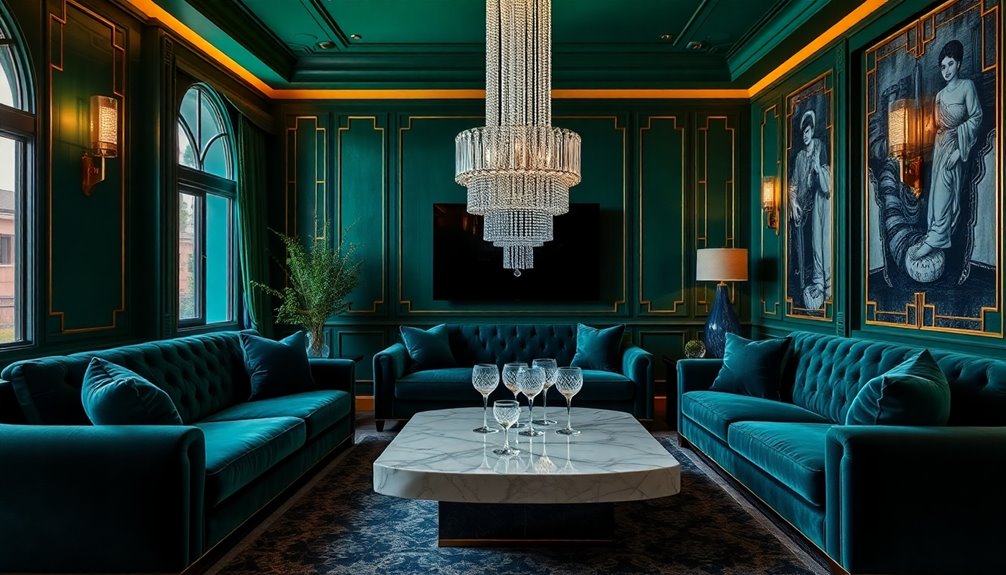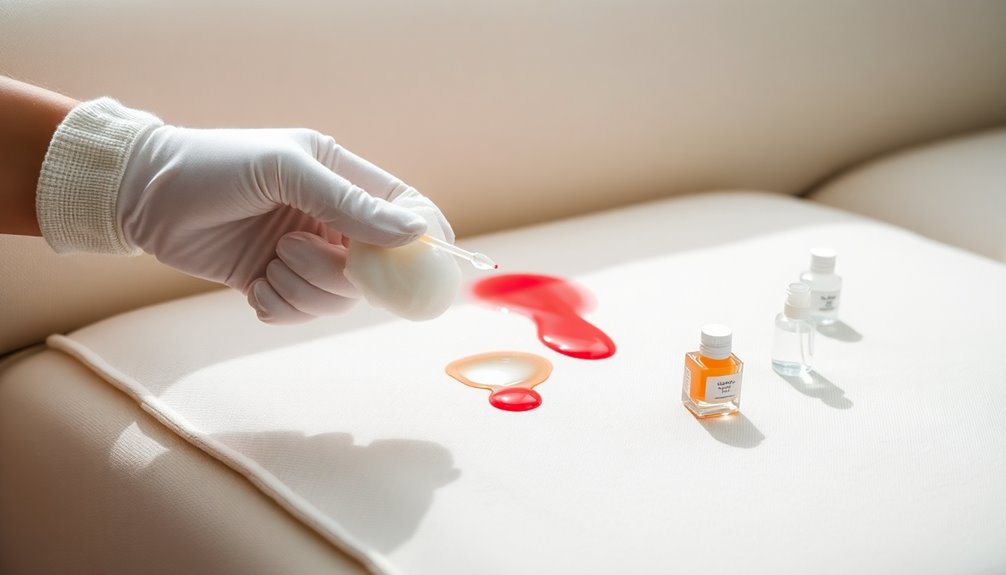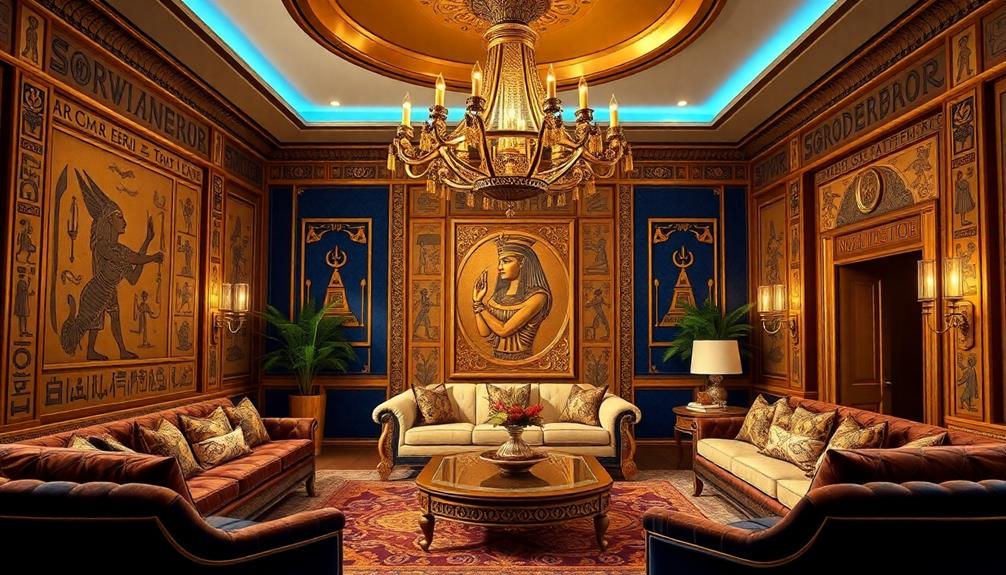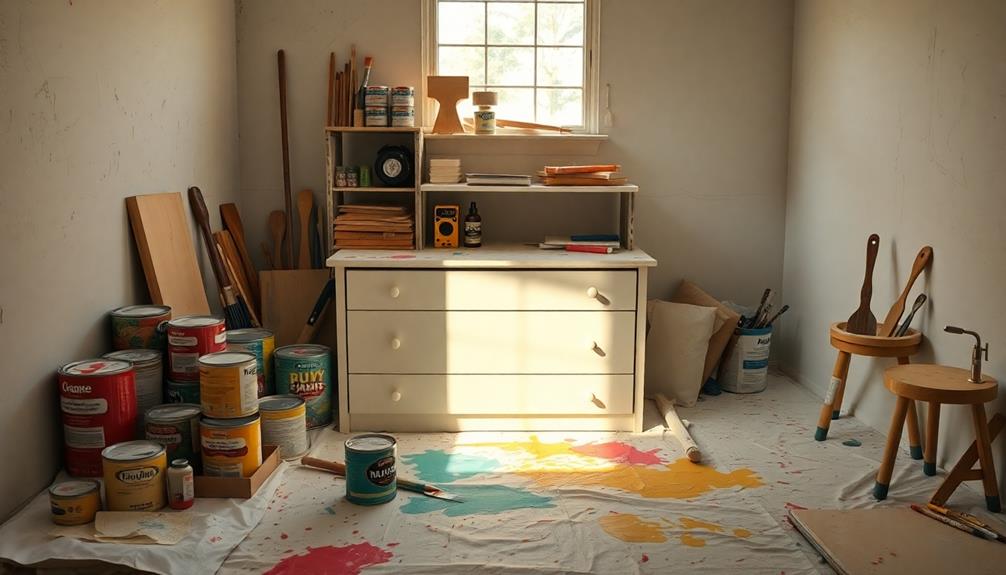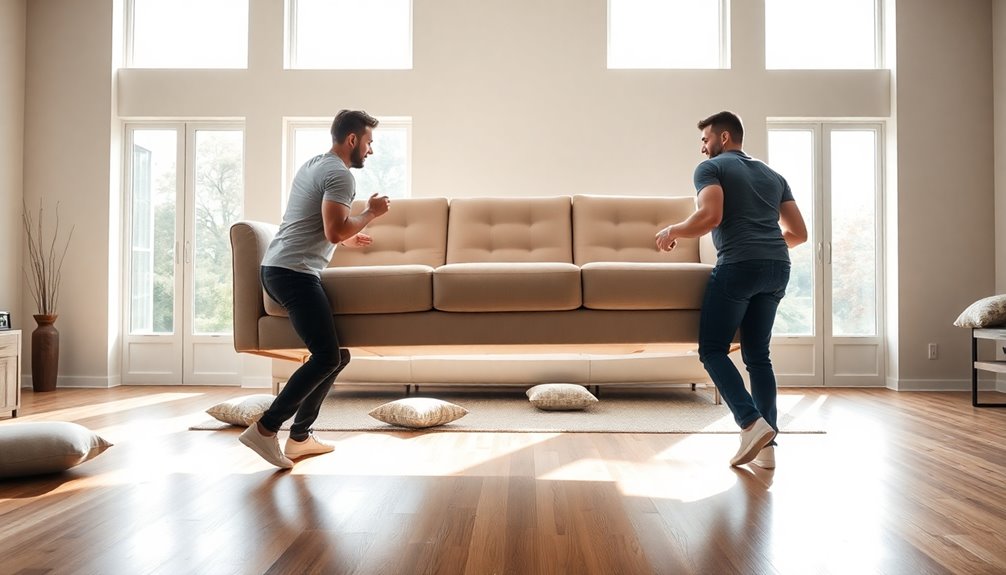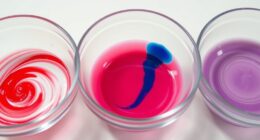You can create authentic 1920s glamour in your modern spaces by embracing Art Deco color palettes. Think bold metallics like gold and silver, paired with rich jewel tones such as emerald green and deep blue. Use striking contrasts—like black and white schemes with vibrant accents—to enhance visual impact. Incorporate luxurious finishes and geometric patterns to capture the era’s essence. Textures matter too; polished woods and plush fabrics add depth and elegance. By mixing these elements, you’ll transform your space into a stylish homage to the Roaring Twenties. There’s so much more to discover about achieving this timeless allure. To further enhance the 1920s aesthetic, consider incorporating vintage-inspired accessories, such as art deco mirrors and statement lighting fixtures, which serve as focal points in any room. Additionally, when hosting gatherings that celebrate this glamorous theme, think about creating inspiring gift bag ideas that reflect the opulence of the era. Fill them with chic, vintage-inspired items like ornate coasters, mini champagne bottles, or elegant candles, ensuring your guests leave with a piece of the enchanting Roaring Twenties to remember.
Key Takeaways
- Incorporate bold jewel tones like emerald green and deep blue to evoke the luxurious essence of Art Deco glamour.
- Utilize metallic finishes such as gold and chrome to create striking focal points and enhance the elegance of modern interiors.
- Combine rich colors with contrasting dark hues for doors and lighter shades for window frames to achieve visual impact typical of the 1920s.
- Layer colors and geometric patterns in textiles and decor to add depth and authenticity, reflecting the era's design principles.
- Embrace classic black and white schemes as a timeless backdrop, allowing bold accents to shine and create drama in modern spaces.
Overview of Art Deco Style
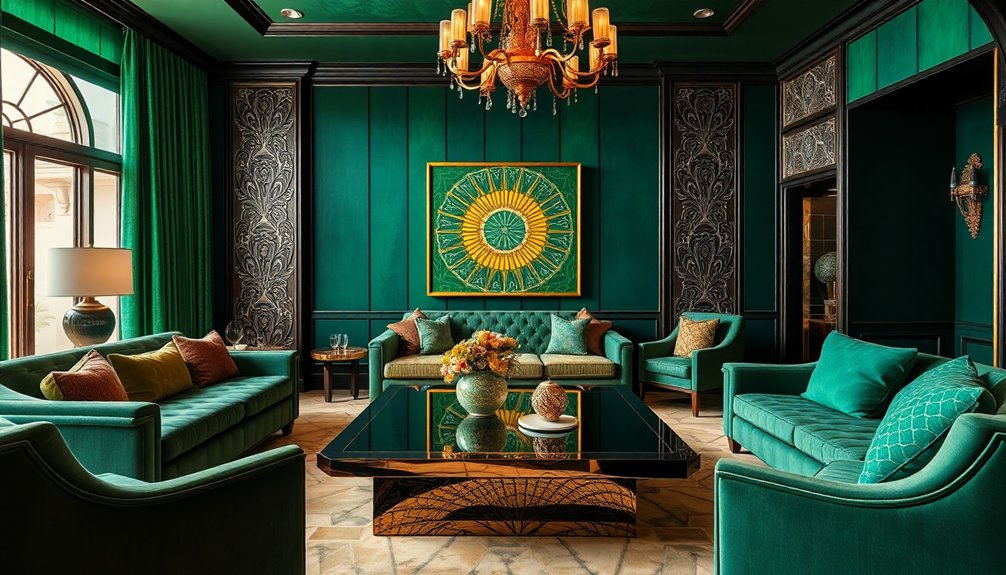
Art Deco embodies a vibrant blend of elegance and modernity, emerging in the early 20th century as a response to the tumultuous cultural shifts of the time.
Originating in Paris during the 1910s, just before World War I, this style captures the essence of an era yearning for innovation and beauty. Named after the 1925 Exposition Internationale des Arts Décoratifs et Industriels Modernes, Art Deco draws influence from various artistic movements like the Vienna Secession, Cubism, and Fauvism, as well as exotic motifs from cultures such as China, Japan, and ancient Egypt. The movement also celebrates technological progress as a reflection of its time, emphasizing its connection to the machine age.
You'll notice characteristic elements like bold geometric forms, clean lines, and stylized designs, including zigzags and chevrons. The style emphasizes symmetry and streamlined shapes, often using luxurious materials like ebony, chrome, and even plastic.
Its vibrant designs reflect the optimism of the 1920s, flourishing in both architecture and decorative arts. Iconic structures, such as the Empire State and Chrysler Buildings, showcase this captivating style.
As Art Deco evolved through the 1930s, it adapted to reflect changing times, yet its legacy continues to inspire modern art and design with its timeless appeal.
Key Color Schemes of the Era
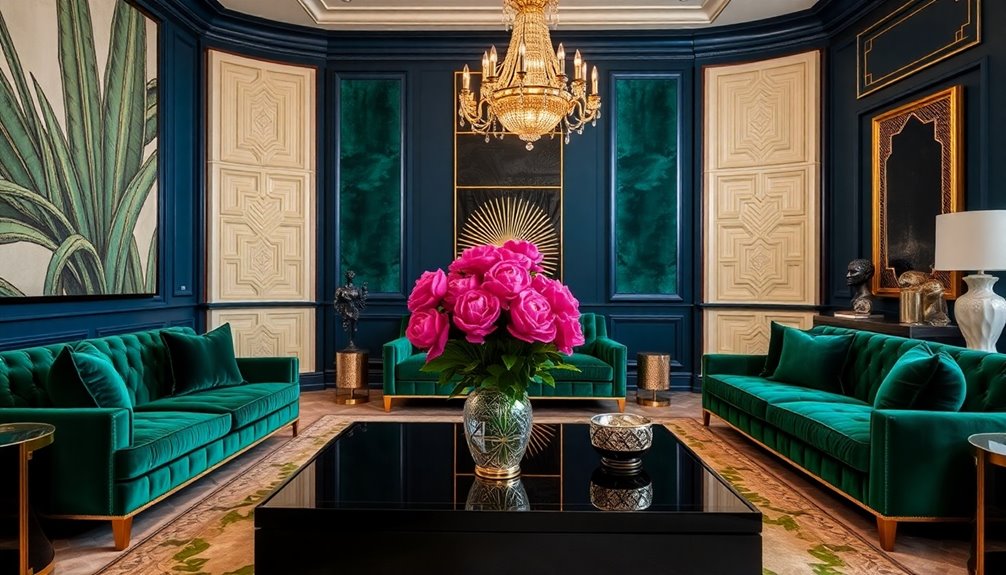
The vibrant aesthetic of the Art Deco movement is vividly expressed through its key color schemes, which played a significant role in defining the style's luxurious appeal.
Metallics, especially silver and gold, were essential in representing wealth and prosperity. You'll find that metallic blues and charcoal greys added to this glamorous feel, while aluminum and chrome finishes provided a modern touch. Often, these metals contrasted with strong, pure colors, enhancing the visual impact significantly. Additionally, the use of metallic finishes in various elements enhanced the overall sense of luxury in Art Deco design. The incorporation of natural materials alongside these metallics can create a harmonious balance in decor.
Black and white emerged as the most popular color scheme during the 1920s and 1930s. You'd notice checkerboard tiles and wallpapers creating a chic and sophisticated look, epitomized by fashion icons like Chanel.
As the 1930s approached, softer pastels like seafoam green and pale blue became popular, offering an escape from the Great Depression. Pairing these soft hues with creamy whites created a sense of aspirational luxury.
Furthermore, neutral and earth tones—warm tans and pale shades of green—often complemented shiny metals and strong colors. This balance maintained the elegant, geometric patterns that defined the era, showcasing the Art Deco's unique charm.
Bold and Bright Colors
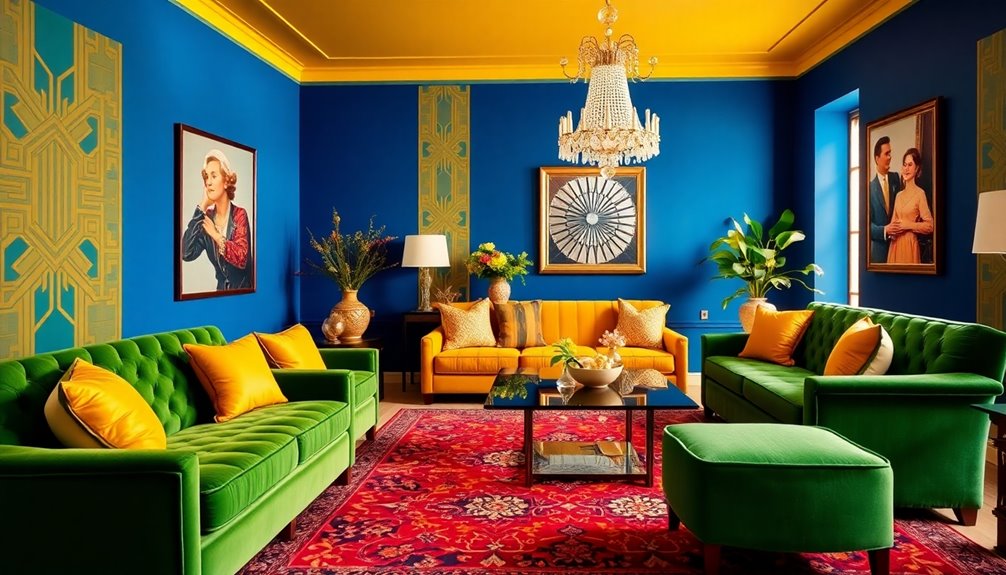
Bold and bright colors infused Art Deco interiors with energy and vibrancy, reflecting the exuberance of the Roaring Twenties. You'll find canary yellow, emerald green, and peacock blue as hallmark colors that echo the era's spirited design. Royal purple and brilliant red added a luxurious touch, while jade greens and rich reds contributed to the overall palette.
Cobalt blues and golden yellows served as striking accents, enhancing the dynamic feel of the space. Incorporating these colors into geometric patterns and stylized motifs celebrates the prosperity of the time. You can use bold hues in wallpapers, floors, and fabrics to create an authentic atmosphere.
For instance, consider contrasting bright colors with softer pastels to achieve a balanced look, or pair them with black and white backgrounds to make them pop. The drama and opulence of these bold colors help craft an ambiance of luxury and wealth. This era's design often featured intricate patterns, adding complexity and depth to the overall aesthetic.
They provide an escape from the drabness of the Great Depression, embodying the optimism of the era. By integrating these vibrant shades into your design, you'll capture the glamour and sophistication that defined the Art Deco movement.
The Role of Metallics
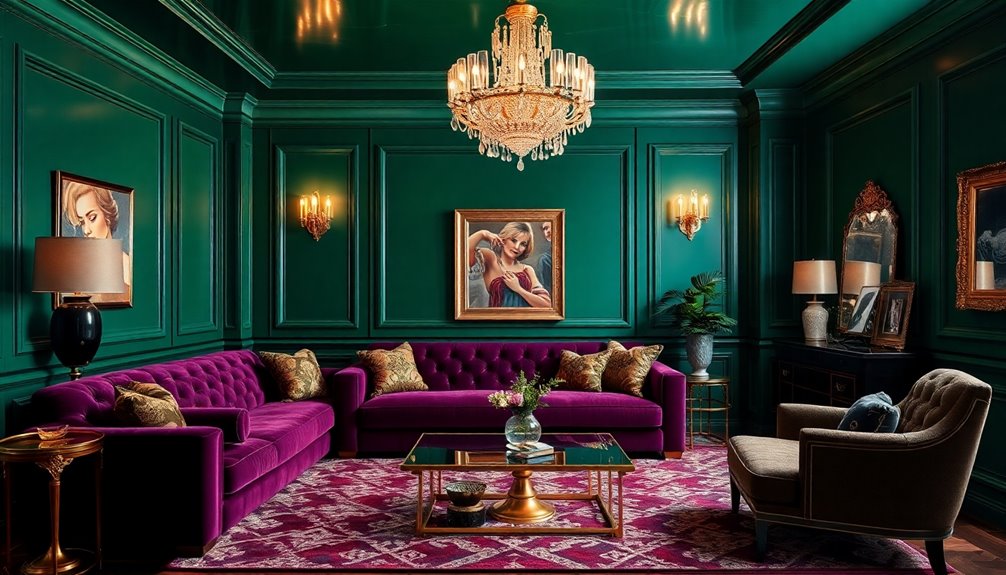
Metallics play a pivotal role in defining the luxurious essence of Art Deco design. These finishes, like silver, gold, and chrome, bring a touch of glamour and sophistication to your spaces.
For instance, silver and platinum are often used in jewelry for their sleek, reflective quality, while chrome-plating adds durability and a modern shine to furniture and fixtures. The affordability of silver jewelry during the 1920s contributed significantly to its widespread use in Art Deco designs. Additionally, butter's rich and creamy texture can inspire the opulence often associated with this era.
Incorporating metallics into your decor can elevate the overall aesthetic. Consider using brass or gold lighting fixtures, such as chandeliers or geometric pendant lamps, to create a striking focal point.
Metallic wallpaper with geometric patterns can also add Art Deco flair without overwhelming your walls.
Don't overlook smaller items like picture frames and trays; they can seamlessly integrate metallic elements into your home.
The contrast of metallics against rich colors like black, red, or green enhances their brilliance and creates a dynamic visual effect.
Impact of Economic Context
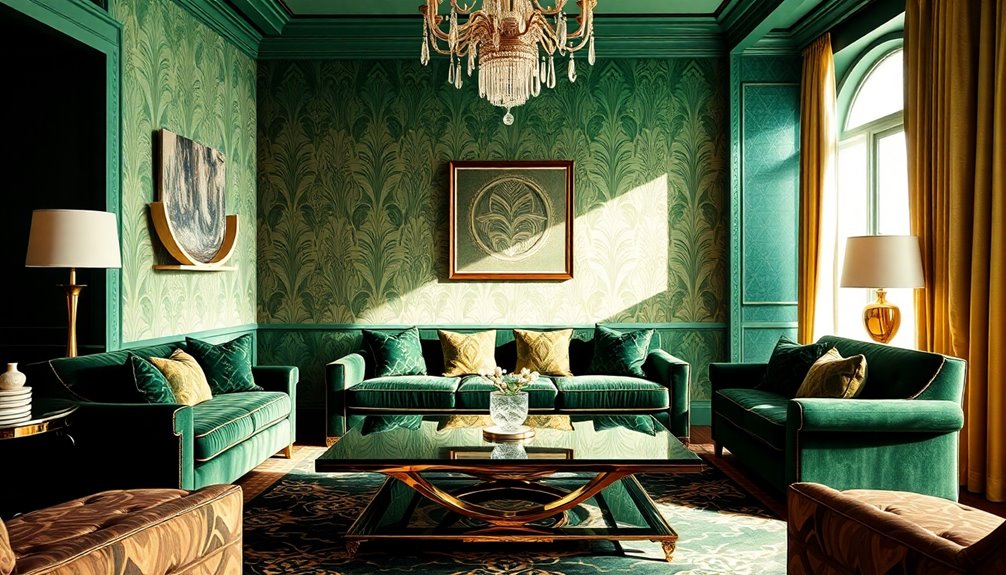
Economic contexts significantly shaped the color palettes of the Art Deco movement, reflecting the era's highs and lows.
During the Roaring 20s, a booming economy led to vibrant color choices that symbolized prosperity. You'd find lively shades like canary yellow and emerald green alongside luxe jewel tones such as jade greens and royal purples, all contributing to the glamour of the time. Black and white schemes added sophistication, while metallics like gold and silver heightened the sense of luxury. The influence of stylized patterns in design further enhanced the appeal of these vibrant colors. Additionally, the use of advanced filtration systems in home decor, mirroring the era's emphasis on innovation, was reflected in the bold experimentation with color.
However, the onset of the Great Depression shifted this dynamic. In the 1930s, soft pastels and clear brights emerged as a form of escapism from economic hardships. Colors like seafoam green and lavender provided an aspirational contrast to the difficulties people faced. Even amid these challenges, richer colors and metallics remained, though in more subdued forms, with pale tones becoming prevalent in interiors.
As the economy transitioned towards the 1940s, color palettes grew more conservative. Patriotic hues like deep reds and dark blues started to dominate, marking a shift toward simpler, less extravagant designs in response to wartime needs.
Architectural Applications of Color
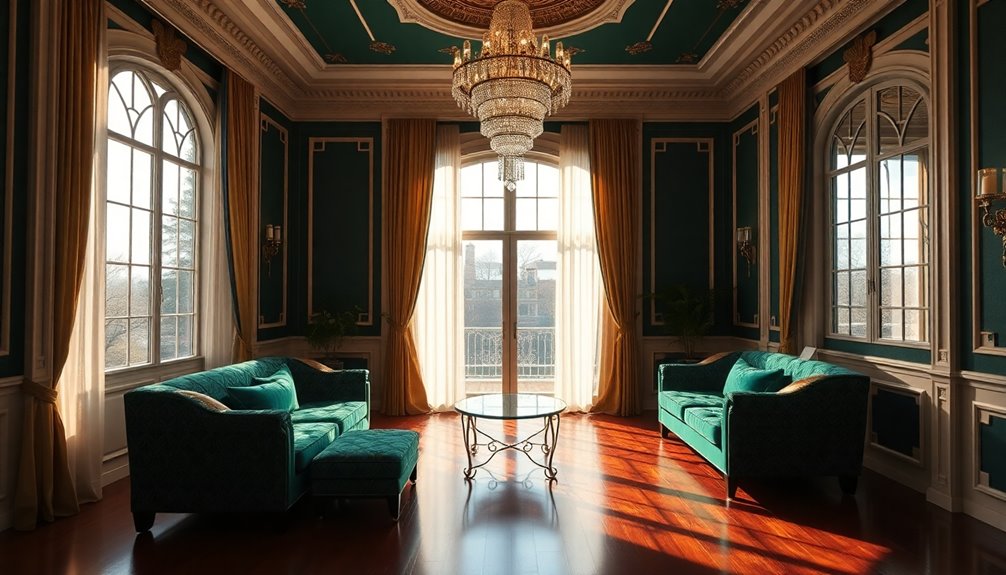
Art Deco's architectural applications of color not only enhance buildings but also define their character. When you observe these structures, you'll notice the strategic use of contrasting accent colors that highlight intricate detailing and patterns.
Main walls often sport white, off-white, or soft pastel shades, creating a canvas that allows other elements to shine. Doors typically come in dark hues like deep blue or rich green, while window frames are often lighter, providing visual balance.
You'll find metallic accents in silver or gold, adding a touch of brilliance and luxury that captures the eye. Geometric patterns and stylized motifs adorn building facades, expressing modernity through vertical panels that create an illusion of height. The use of rich colors like jade green and peacock blue-green enhances the overall vibrancy of these structures.
Mosaics and terracotta elements add a fanciful flair, showcasing exotic inspirations from cultures around the world. Color combinations play a crucial role too; warm tans and pale greens mingle beautifully with jewel tones like jade green or peacock blue-green.
This thoughtful interplay of color and material not only elevates the architectural beauty of Art Deco buildings but also reflects the vibrant spirit and aspirations of the era.
Interior Design Elements
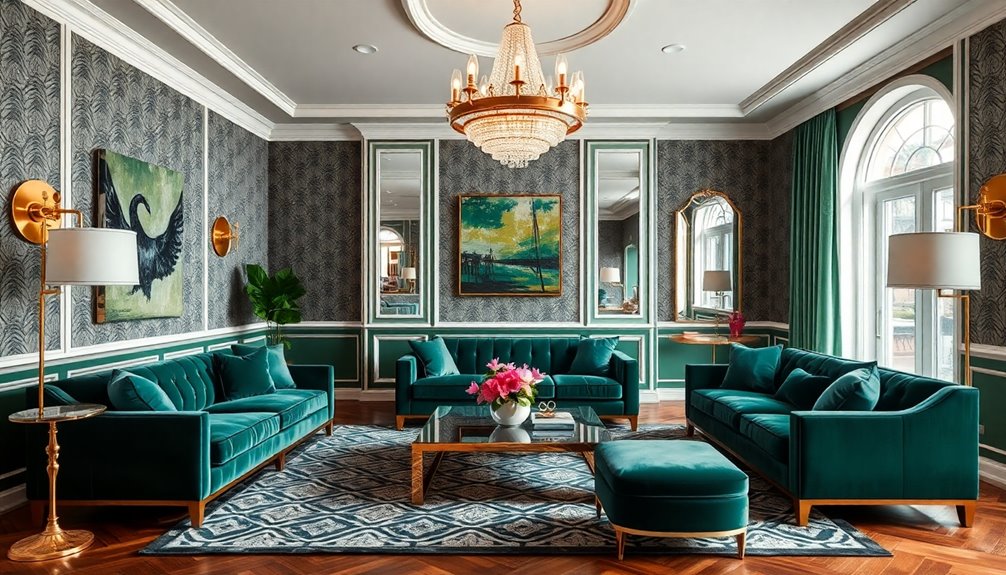
Building on the striking colors and patterns of Art Deco architecture, interior design elements further enhance the style's distinctive flair. To create an authentic look, you'll want to embrace bold, jewel-toned color palettes, such as deep yellows, reds, and blues, punctuated with black, white, and shiny metallics like gold and silver.
These rich hues can act as a sumptuous backdrop for your walls, window dressings, and upholstered furnishings. Incorporate geometric patterns through wallpaper, textiles, and flooring, utilizing zigzags, sunbursts, and angular motifs that epitomize the Art Deco style. Choose luxurious materials like polished wood, velvet, and chrome for furniture and accessories, ensuring your pieces have streamlined forms and substantial presence.
Lighting is also crucial; opt for glass and chrome fixtures featuring geometric designs that reflect the era's glamour. Think about incorporating mirrors with inlaid patterns to add depth and sophistication. The use of luxurious materials in Art Deco design contributes to its lasting appeal and elegance.
Accent Colors and Finishes
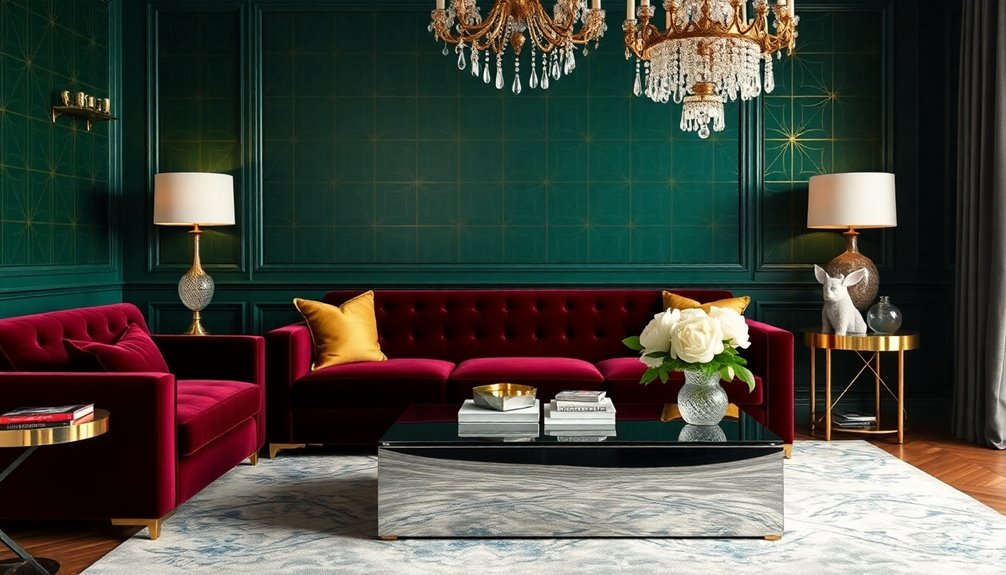
Vibrancy and elegance define the accent colors and finishes of the Art Deco style, creating a striking visual impact. To infuse your space with the opulence of the 1920s, consider incorporating metallic accents. Silver and gold add a luxurious touch, while metallic blues and charcoal greys bring a modern edge.
Use aluminum and chrome to contrast with bolder colors, enhancing your decorative scheme. Applying metallic finishes in lines or dusting them over rough surfaces adds brilliance and character.
Don't shy away from bold and bright colors like canary yellow, emerald green, and peacock blue. These luxe jewel tones symbolize the prosperity of the Roaring Twenties and work beautifully as accents against lighter backgrounds. Additionally, the color palette of Art Deco often features contrasting bright colors that create visual impact, making your space feel vibrant and dynamic.
Pairing strong colors with whites and creams creates a striking contrast that's both uplifting and glamorous. Alternatively, explore soft pastels if you prefer a calming atmosphere. Seafoam green and muted gold can create an aspirational vibe, especially when paired with slightly shaded whites.
Lastly, a classic black and white scheme remains timeless. This ultra-sophisticated backdrop allows your bold accents to truly shine, capturing the essence of Art Deco glamour in your modern space.
Geometric Patterns in Design
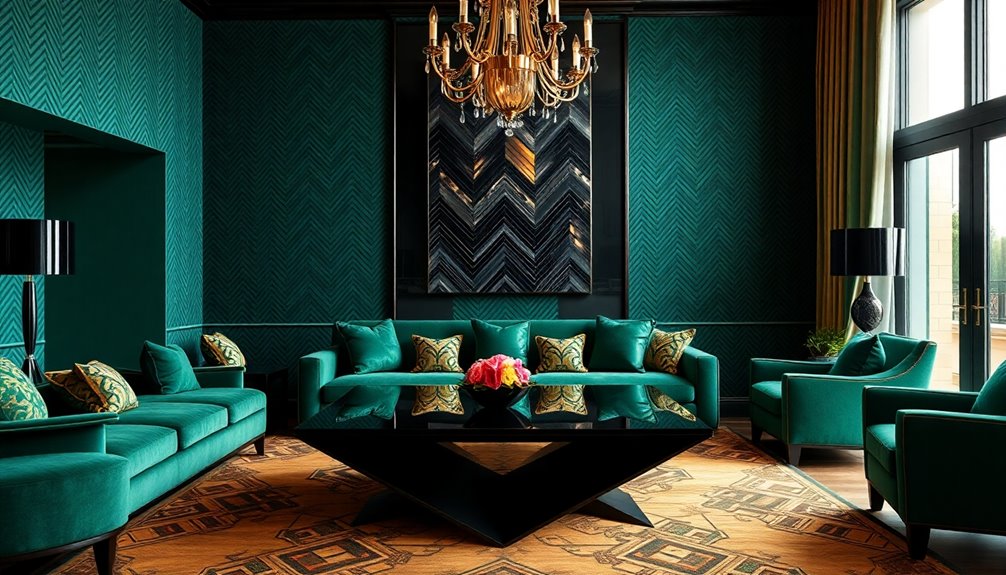
Incorporating bold accent colors and finishes can naturally lead to the exploration of geometric patterns that define the Art Deco style. These patterns aren't just decorative; they're integral to creating a sense of modernity and progress in your space.
When you look at architecture from the era, notice how vertical panels and monolithic forms create a striking illusion of height, enhanced by applied ornamentation featuring geometric shapes.
In interior design, you'll find geometric patterns in wallpapers, tiles, and flooring. Think black and white checkerboard designs that add a classic yet contemporary flair.
Combine soft pastels and vibrant brights to contrast with richer colors, bringing drama into your interiors, especially with stained glass and lead-light windows that showcase geometric motifs.
Additionally, merging geometric patterns with metallic accents like silver and gold introduces an element of luxury. Rich colors such as emerald green or royal purple symbolize prosperity and work beautifully together.
Balancing these patterns with warm tans or pale greens creates a harmonious aesthetic, reflecting the era's optimism and industrial spirit. Embrace these geometric elements to capture the glamour of the Roaring Twenties in your modern space. Incorporating vibrant brights can further enhance the visual appeal and create striking contrast against more subdued tones.
Modern Interpretation of Art Deco
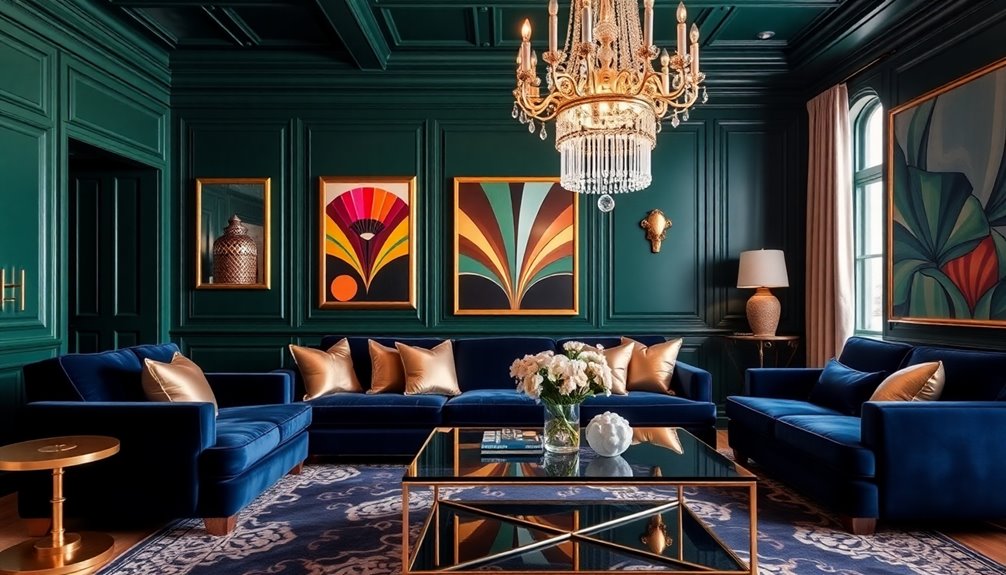
Art Deco's modern interpretation brings together rich colors and luxurious materials to create spaces that exude both energy and sophistication.
You'll find vivid greens, opulent golds, and other bold hues that inject life into contemporary designs. These striking colors shine in accent pieces like mirrors, lighting fixtures, and statement furniture, allowing you to maintain versatility while still embracing the Art Deco ethos.
Modern interpretations also seamlessly integrate contemporary materials. Plush velvets, intricate wooden inlays, and chrome accents elevate your space, combining high-quality craftsmanship with modern manufacturing techniques. This blend of traditional and contemporary materials ensures that your design remains timeless yet fresh. Additionally, the use of lavish materials enhances the richness of the overall aesthetic, drawing on Art Deco's celebration of opulence.
Ornamentation plays a crucial role too; you can enhance emotional resonance with sunburst designs, intricate motifs, and symbolic icons.
Think ornate mirrors and bold geometric wallpapers that capture the essence of Art Deco while fitting into both minimalist and maximalist philosophies.
Tips for Integrating Glamour
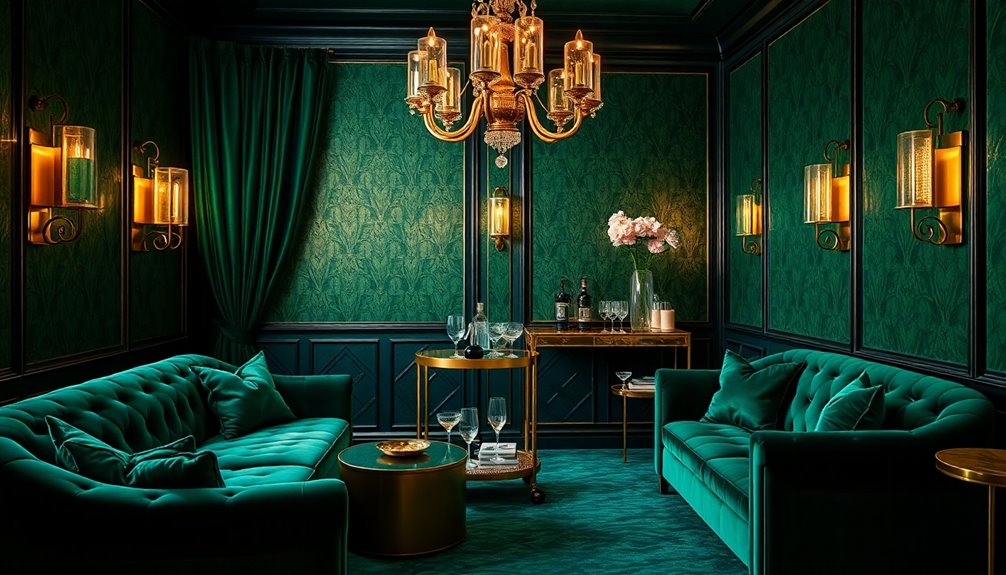
Glamour is the heartbeat of Art Deco design, and integrating it into your space can transform the ordinary into the extraordinary.
Start by choosing bold and bright colors like canary yellow, emerald green, and brilliant red to evoke the lively spirit of the 1920s. Pair these with metallic accents in gold and silver to enhance the luxurious feel. Consider a classic black and white scheme for floors or wallpapers to create a sophisticated backdrop.
Incorporate geometric patterns—think chevrons and zigzags—to add that quintessential Art Deco flair. Utilize luxurious textures like velvet, chrome, and glass to create depth and opulence. Large mirrors and glass accents can reflect light, amplifying the glamorous atmosphere.
Balance your palette with soft neutrals and earth tones to maintain harmony. Use striking accent colors against subdued backgrounds for visual interest.
Frequently Asked Questions
What Are Some Common Art Deco Furniture Styles?
You'll find common Art Deco furniture styles include waterfall pieces with rounded edges, club chairs with rolled arms, and skyscraper designs emphasizing geometric forms. Look for luxurious materials and intricate details to enhance your space.
How Can I Source Authentic Art Deco Decor Items?
To source authentic Art Deco decor, visit vintage stores, explore flea markets, and check online marketplaces like eBay. Attend auctions and join collector groups for unique finds that capture the era's essence.
What Materials Are Typically Used in Art Deco Furnishings?
In Art Deco furnishings, you'll often find high-end materials like marble, chrome, and glass, alongside exotic woods such as ebony and zebrawood. Luxurious textiles, metallic accents, and reflective surfaces enhance the overall glamorous aesthetic.
Are There Any Notable Art Deco Artists to Study?
If you're exploring Art Deco, study artists like Tamara de Lempicka for her glamorous depictions, Erté for fashion design, and Cassandre for vibrant graphic work. Each brings unique elements to this captivating style.
How Can I Incorporate Art Deco Elements Into Smaller Spaces?
To incorporate Art Deco elements into smaller spaces, use bold colors, metallic accents, and geometric patterns. Choose statement furniture and mirrors to create depth, while balancing with neutrals to prevent overwhelming the area.
Conclusion
By embracing the vibrant color palettes and bold patterns of the Art Deco era, you can effortlessly infuse your modern space with 1920s glamour. Don't shy away from metallics and accent colors; they'll elevate your design and create a lavish atmosphere. Remember, the key is to balance these elements harmoniously while adding your unique touch. With these tips in hand, you're ready to transform your environment into a stunning homage to the elegance of Art Deco.
